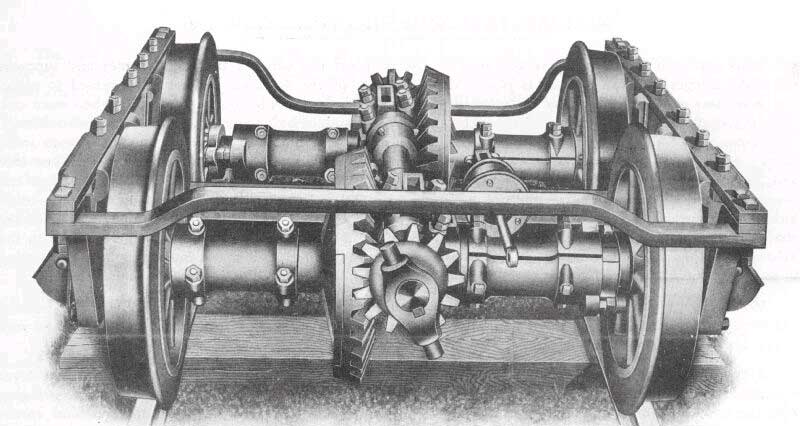
In the illustration above (Geared Steam Locomotive Works ©) , note that each axle in the truck is geared, and the line shaft is above the axles. This arrangement was unique in logging locomotives and required specially cut "skew" gears. Climax had designed these gears by trial and error in a wooden model which was then used to cast the steel gears. The Class A Climax was also unique in having a two speed transmission, the standard joke goes that the gears were "slow" and "slower". When changing gears, the engineer had to match the speed of each revolving gear as there was no clutch. Class A transmissions also had a neutral position, a dangerous but often used option going down hill. Early Class A's also had diffential gearing on each axle, but this proved to be impractical and was dropped as an option. The intended market was small loggers needing a cheap tram road locomotive that would quickly wear out. Climax and the other manufacturers learned that their machines could run almost indefinitely; the amount of used locomotives on the market was a hindrance to selling new ones.
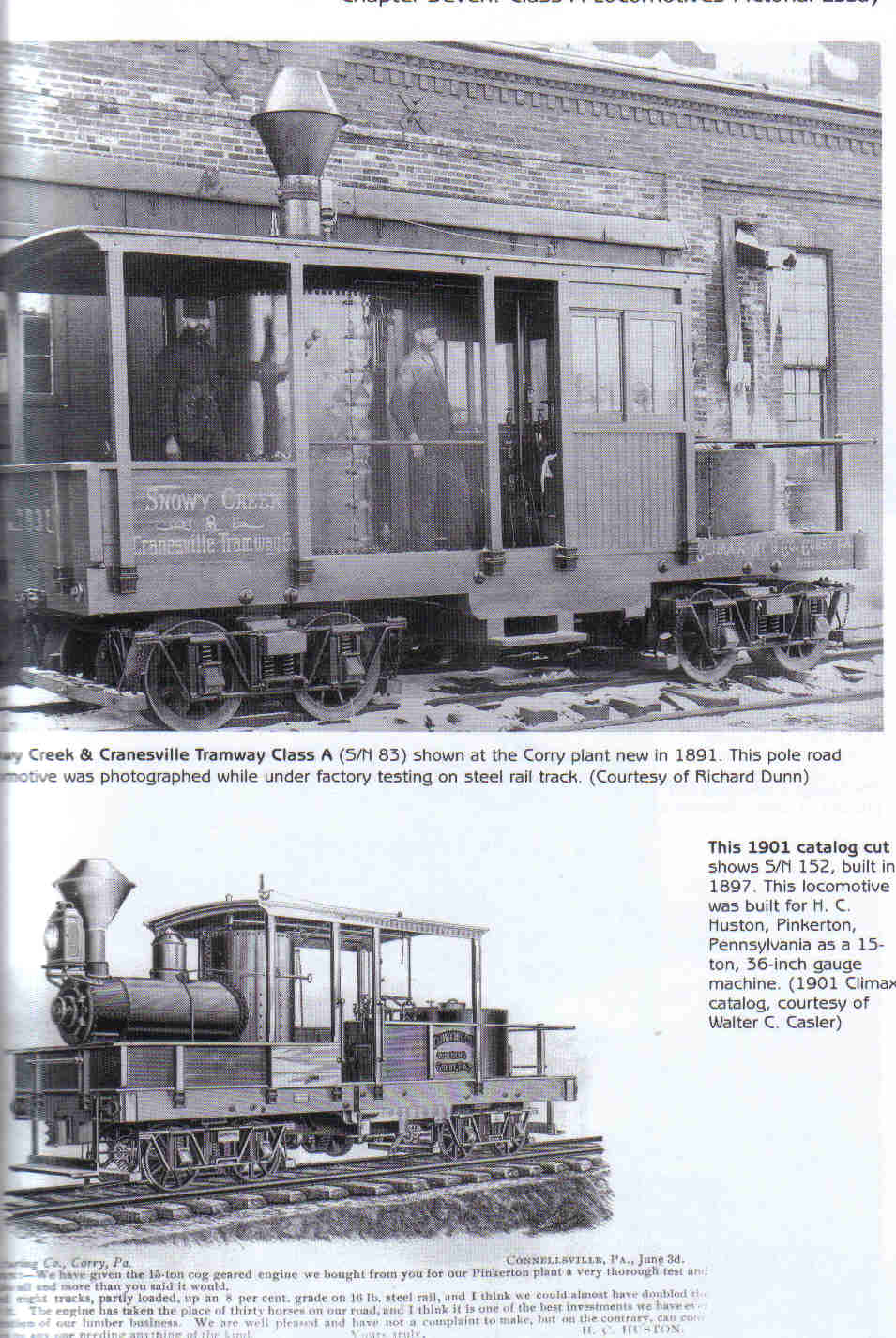
The top photo is Climax construction number 83 built in 1891, the only known Class A to operate in Garrett County. The Snowy Creek and Cranesville was owned by Sylvester Rinard, Garrett County and the Albrights of Preston County. Rinard was logging the red spruce, hemlock and tamarack of the Cranesville Pine Swamp for some time before the locomotive was bought. Note the wheels on the locomotive; this concave type was designed for pole roads, the most rudimentary tram road in which skinny trees were delimbed and laid end to end. Picture evidence shows that at least part of the Snowy Creek and Cranesville was a stringer road, but whatever, logging railroads were environmentally sound as they often reverted quickly back into the natural surrounding.
Mrs. Alice Eary, noted Garrett County historian and resident of the Cranesville neighborhood, recently mailed several articles on the operation of the Snowy Creek and Cranesville Tramway and the Climax locomotive that was unofficially named the "Swamp Angel". One article from This Green Glade by Jo Ann Sereno Teets revealed that the tramway was 11 miles long and consisted of a three-ply wooden rail, the bottom two were hemlock and the top was various hardwoods. The plies were overlapped in order to provide an early example of continous rail. A minor mystery is solved about the flanged wheels; although the "mainline" was the three-ply rail, the temporary routes to logging locations were tamarack poles on crossties. This writeup states that Mr. Rinard was a pioneer in this type of pole road and helped Climax develop a locomotive to run on it. The top speed of the Swamp Angel was given as a somewhat speedy (for a Class A) 20 miles per hour. Climax historians can agree or disagree with these claims. This article, as well as another unpublished manuscript by Evelyn Guard Olsen ( author of Indian Blood), states that a Mr. Lakin and D.E. Offut were involved in the Cranesville enterprise. I believe Mr. Offut, an Oakland lawyer and merchant, was also associated with the Preston Railroad and related mill at Crellin. The Olsen manuscript (which, like Indian Blood was local history written in the form of a novel or short story) also states that the Rinard operation existed before the time of the Swamp Angel and possibly was a sled ice road. Products included whole logs, lumber, cross ties, telephone poles and ship spars. The photo at the bottom of this section shows the Swamp Angel in what would become a typical logging railroad consist, log cars in front and behind the locomotive. This arrangement allowed steep grades to be "doubled": that is the cars behind would be uncoupled while the locomotive pushed the front cars up the grade where they were parked while the locomotive went back and hooked up to the cars behind the locomotive to pull them up the grade. A more formal name for the area is the Cranesville Subarctic Swamp, aptly describing the microclimate of the natural frost pocket that supports some flora at their southernmost limit . Those who are familiar with Garrett County winters will understand why the railroad did not run during the cold and snowy months. While the railroad was shut down, timbering continued and when the weather would break in the spring, local farmers were employed to load the log cars that would run six day a week. A final article also sparked considerable interest; it is the story of Keith Mason of Clarksburg WV who modeled the Swamp Angel in practically full scale narrow gauge (the original tramway is listed by Kline as 60 inch gauge) around 1974 and ran in on some track built around his suburban home. The early example of a garden railroad was named the Locust Heights and Western Railroad and was accompanied by a steam-powered sawmill. Apparently this operation still exists as a fairly recent agenda for a railroad club in Morgantown listed this model railroad in its tour itinerary. This article states that the real Swamp Angel spent its final years hauling limestone from a quarry near today's Alpine Lake, although a year of its closing or the disposition of the locomotive is not given. Many thanks to Mrs. Eary!
The bottom photo is on the same page of the Climax Locomotive(cite above)book. Class A's operated in nearby Somerset County including the one shown at Pinkerton. Rinard's locomotive used an upright boiler, Climax had been producing these boiler to use on their oil pumping products. Huston's locomotive used the more efficient "tee" boiler similar to the one used on mainline rod locomotives. The "steam engine" in these locomotives were located between the boiler and the round water tank. The engine, like the boiler, was adapted from oil pumping products that Climax produced, but was similar to vertical marine engines used in small steam launches. As a matter of fact, take the trucks off of a Class A and add a hull and propeller and you would have the African Queen. Note that both Class A's had a wooden frame. More durable Class A's had a steel frame. These photos show another Climax feature. Note that each axle is sprung above the journal bearing (the end of each axle) in addition to the spring in the center of the truck frame. This produced a very limber truck that could handle uneven track without any loss of traction. Class A's were not a early version that evolved into more modern Class B's (and later Class C's) but was rather a machine designed for a specific purpose. Class A's could be ordered as long as Climax was in business. When the erection floor shut down in 1927, a Class A was being built. Only one Class A is known to exist today.
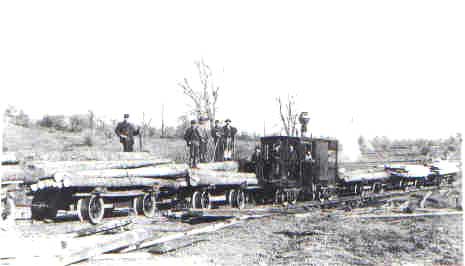
The Snowy Creek and Cranesville Class A Climax in use at Pine Swamp before the turn of the century. As far as can be determined, this was the only Class A to operate in Garrett County. Walter C. Casler Collection. Print owned by Dave Cathell
Climax B
The Class A was limited in size because of the arrangement of its components. Class B was Climax's answer when a locomotive of 20 tons or more was needed. The vertical steam engine was replaced with regular locomotive pistons that drove a flywheel and shaft geared into the line shaft. The first 5 Class B's produced retained the two speed gearbox of the Class A, but the arrangment proved to be too complex on the larger locomotives and was dropped. Jennings Brothers was the owner of one these rare Class B's. Although it was reported in one source as operating in Garrett County, Kline makes not mention of this locomotive being at Jennings, Maryland. The rest of the Climax production was built with inclined cylinders as shown in the photos below.
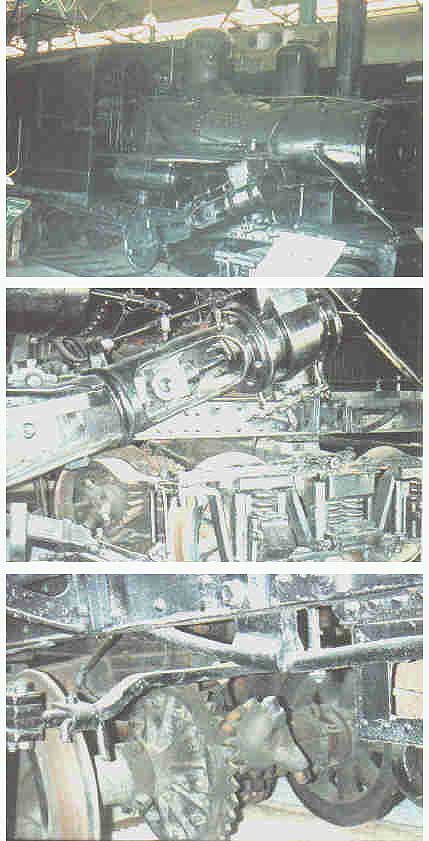
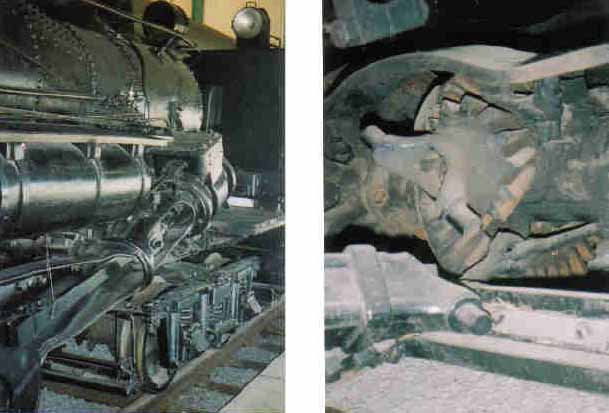
A later Class C version featured three powered trucks but was used mainly on the West Coast. Whenever a logging railroad owned both a Climax Class B and a Shay, the operating personnel usually preferred the Climax.
Garrett County Logging Railroads Using Climax Locomotives
Note- not all links are completed
Sources
http://www.climaxlocomotives.com/history.html
Shay
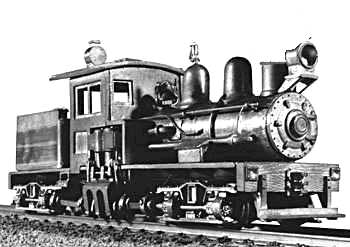

The trademark of Shay was the line shaft that powered the truck via bevel gears on the outside of the wheels. This arrangement,although effective, meant that a Shay is a dangerous machine to get close to while moving. Vertical cylinders mounted on the right side caused the boiler to be offset to the left.

Andy Lantz writes "I am the son of Harold Lantz, engineer for the Preston Railroad. The next time you edit your WEB page remove the word "probably" Harold Lantz; you are correct in all cases that the engineer was my Dad (editors note: this comment refers to photos on the Preston RR page). The Shay picture (above) with 3 crew members is Jacob Hayes (my Grandfather) in the Cab and I believe it is my Dad on the cow catcher. I'll verify that when I get a chance by doing a high resolution scan on my copy of the picture. I had found your WEB page months ago and meant to write an email but never got the time. I felt I had to do it now since your site was responsible for letting me know about the WV RR Museum and the fate of #18 & #19. I wish my father had lived long enough to see them attain such an honor. Andy goes on to say that he has photos of "train wrecks, Otter Creek Boom and Lumber, WM and I believe the Caflish RR out of Hambleton. I have discovered while doing family history research that besides Dad and Jake, my other Grandfather, William Lantz, was also a railroad engineer. Enough for now ... I ramble too much!! I will never forget the feel of the brass brake handle and moving the gear lever (with Dad's help) on the occasions when I was allowed to ride. I guess it was a small benefit of childhood in the small town of Crellin and a father who was the railroad engineer.
Andy Lantz
Garrett County Logging Railroads Using Shay Locomotives Note links are not completed
Sources
http://www.shaylocomotives.com
Heisler
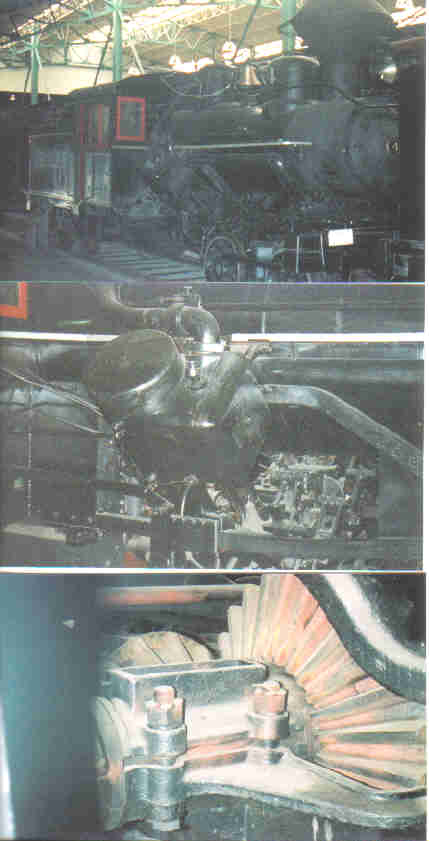
Several Heislers operated in Maryland. The small Blue Jay Lumber Heisler went to the West Coast after operations closed at Pocahantas.
Garrett County Logging Railroads Using Heisler Locomotives
Note- not all links are completed
Blue Jay Lumber |
Dubois & Bond Bros |
A.W. Cook |
Morrison Gross Co |
Gilbert
A rare fourth logging locomotive was amply respresented in Garrett County, the Gilbert Locomotive produced by Dunkirk Engineering in New York. George D. Gilbert, you will recall, patented the Climax Class A design. After leaving Climax, he associated with Dunkirk for a brief run of Class A logging locomotives at Dunkirk.
Garrett County Logging Railroads Using Gilbert Locomotives
Note- not all links are completed
A Knabb & Co |
Kendall Lumber |
Geo. W. Wilson |
McMillan Lbr. Co |
Logging Railroads Accessing the Baltimore & Ohio West of Oakland Maryland Area
Preston Lumber and Coal Co-Preston RR Sylvester Rinard-Snowy Creek and Cranesville Tramway Robert W. Garrett interests-Skipnish RR George D. Browning-logging railroad Henry G. Davis-tramroad Stemple & Casteel-tramroad Narrow guage railroad connecting at Swanton-reported in West End Dubois and Bond Brothers-Savage River Railroad A.W.Cook, North Maryland Lumber (possibly also referred to as North American Lumber), and Dimeling and Bloom -Savage River Railroad Lochiel Lumber, Mining, Manufacturing and Improvement Co. Listed by J. Thomas Scharf (circa 1880) as the largest in Maryland at that time, the company was incorporated in 1868. Kline reports that they used Savage River for transport of logs to the 37'x 87' mill at Bloomington. J. Livingston was the superintendent and perhaps the former owner. The company was associated with the Pennsylvania Standard Oil Company. White pine timber was purchased as far north as Black Lick on approximately 1,200 acres in the Savage River valley. F.H. Whaley-private logging railroads in Maryland and West Virginia McKelvey Forest Products/Potomac Lumber-private logging railroads in Maryland and West Virginia Morrison & Gross-private logging railroad in West Virginia Clark and McCullough A.Knabb and Company-Manor Lands and Oakland RR Kendall Lumber Company--Manor Lands and Oakland RR Meadow Mountain Lumber Company-Bear Creek RR Lock Haven Lumber-Bear Creek RR Johnstown Planing Mill co.-Bear Creek RR Jennings Brothers-Jennings Brothers RR J.B. Davis-Jennings Brothers RR First sawmill in Garrett County-1790 Phillip Hare, First steam sawmill in Garrett County-1837 Williams, Brown on the past and future of the Garrett County forest industry in 1888 Large Lumber and Timber Products Companies Wood Products Inc-Oakland Allegheny Wood Products- Mt. Storm, Kingwood, Petersburg and Hazelton WV Locations Coastal Lumber Company-Horse Shoe Run, Hazelton WV Locations Kessel Hardwoods Inc- Keyser WV Aetna Lumber Company- Keyser WV Ronald Frazee Lumber Company- Friendsville MD GrimmLumber Company- Terra Alta WV (mill close to Crellin) Sypolts Enterprises- Rowlesburg WV Taz Timbers- Bruceton Mills WV
1891-1905
Mill-Crellin- Interchange with B&O-Hutton Switch-Timber-Yough and Laurel Run drainage
Albert Lewis (an early hard coal baron), Lucerne Co, PA-sold to W.R. Butler, Roland Crellin, White Haven PA and several local men from Oakl
Circular-60,000 ft.
3 rod engines of unknown builder,2 were 4-4-0, named Old Black Joe, A. Lewis and Old Dewey
0-4-0 Porter, unknown source, named Four Spot
No.5 4-6-0,Lehigh Valley
all went to Kendall Lbr in 1906 as well as the mill (a rebuilt one, the first one burned in 1902) and timber
See Crellin Maryland for more information-use "Back" to return here
Kendall Lumber Co-Preston RR
1906-1925
Mill-Crellin- Interchange with B&O-Hutton Switch-Woods Headquarters-Shafertown, WV-Timber-Cheat River Drainage-Preston and Tucker Co.,WV
Samuel A. and Jacob L. Kendall, Greenville Twp PA
Circular and Band Mills-100,000 ft.
Preston RR was incorporated separately 1905 and chartered 1906
Five locomotives were purchased from Preston Lumber & Coal
No. 6, 2 truck Shay, New, built 1906 C.N.1693, 42 tons,scrapped 1930's
No. 7, 4-6-0 Pittsburgh, Used-built 1883-purchased from B&O, scrapped unknown date
No. 8, 3 truck 42 ton Shay,Used, built 9106 C.N.1727,scrapped date unknown
No. 9, 2 truck 65 ton Shay,Used, built 1906 C.N.2779,sent to another Kendall job 1912
No. 10& 11,leased B&O rod engines
No. 12 & 16, 3 truck, 65 ton Shay, used,left Crellin for another job, brought back in coal mining era,scrapped in 1951
No. 14, 3 truck, 65 ton Shay, used,built 1907 C.N.1908, from Duluth & N. Minnesota, scapped
No. 15,2-6-0 Baldwin, used, built 1914,CN 41465, from Laurel River Lbr, Jenningston WV, scrapped
Stanley Coal-Preston RR
1925-1960
Mine-Turner-Douglass, WV- Interchange with B&O-Hutton Switch
Samuel A. Kendall, Greenville Twp PA, Erval Ream,Stanley Ashby and Lester Yutzy, Crellin
No. 17,0-6-0 Baldwin,used, built 1905, WM Rwy,sold to Duluth & N. Minnesota(after tearing up the Preston track)
No. 18 & 19, 2-8-0 Baldwins, used, built 1904 & 1906, C.N. 24738 & 28500,West Virginia Northern, Kingwood WV,sold to Earl Leap, Madley PA and reportedly to WV Railroad Museum (2005)
See Crellin Maryland for more information-use "Back" to return here
1882-1895?
Rinards Crossing WV (Hopemont)-interchange with B&O-tramway and mills-Cranesville Pine Swamp
..
..
Class A Climax, Built 1891,C.N.83, new, 13 tons, scrapped?
...
1897-1910
Interchange with B&O-Skipnish, MD-railroad and mills-Herrington Manor to Browning Dam on Muddy Creek
logging railroad operated by the B&O
portable mills
Class B Climax, Built ?, new,__tons, went to Holly River WV
...
1915-1925
Interchange with B&O-Oakland, MD-timber and mills-Deep Creek area
probably used H.G.Davis' tramroad grade after reaching Hammel Glade
portable mills
Class B Climax, Built ?, used,possibly one of the Kendall small Climaxlocomotives __,tons, went to _____
Quite a logging railroad for such a small operator. Later used by the contractor for the dam for Deep Creek Lake
See 88 Bridge for more information-use "Back" to return here
See Oakland Maryland for more information-use "Back" to return here
Logging Railroads Accessing the Baltimore & Ohio East of Oakland Maryland
1867-1892
50" guage with strap iron, 12 miles
Used mules for power
Davis would later own larger railroads in West Virginia and candidate for Vice President of the U.S.
Henry G. Davis biographical data-use "back" to return here
late 1800's
50" guage
animal power
Meadow Mountain area, joined Davis' tramroad near Thayerville
late 1870's
might have possibly been a tramroad from Beckman or one of the companies listed in Swanton
more than likely animal power
Saw Mills listed in Swanton 1878-
Beckman, Theo.,
West, C. T.
seeking help on this operation
1900-1910
Bond, Maryland
five Bond brothers from Brockwayville, Pennsylvania and John Dubois, Dubois, Pennsylvania,
Single band mill-80,000 ft.
2 truck Heisler, 37 tons, built 1901, C.N. 1053, went to Perry Oregon (perhaps with A.W. Cook
3 truck Shay, 65 tons, built by Lima, used?, went to A.W. Cook
Rod engine, 28 tons, used for "mainline" to B&O, other information unknown, went to A.W. Cook
This 8,600 acre timber venture included one of the legends of Pennsylvania lumbering, John Dubois. Mary Bond Weber, daughter of N.U. Bond, would continue as a Garrett County resident and greenhouse business person. The connection with the B&O was listed as Crabtree; Floyd and Frankville were the same location or close by; the town at the sawmill location (at the junction of Big Run and Savage River)six miles up river was called Bond. At some point, the location on the railroad, which featured a operating tower and a runaway spur was renamed Bond
1910-1917
Bond, Maryland
Bond and Dubois sold to another major Pennsylvania lumberman,A.W.Cook from Cooksburg Pennsylvania. Cooks formed North Maryland Lumber which was sold to Dimeling and Bloom from Clearfield, Pennsylvania
Single band mill-80,000 ft.
3 truck Shay, 65 tons, built by Lima, used?, went to Dimeling and Bloom
Rod engine, 28 tons, went to Dimeling and Bloom
The Bond and Dubois Brothers operation went in quick succession to the owners listed above. A.W. Cook was cutting in northern Garrett County at this time to supply a mill in Unamis Pennsylvania (near Confluence) North Maryland Lumber bought uncut B&DB timber and they owned additional acreage near the head of Savage River. These operation traded timber tracts with Jennings Brothers and R. Newman and Company of Elklick (Salisbury) Pennsylvania.
The transfer to Dimeling and Bloom reported two log loaders in use, making on one logging locomotive on the property hard to imagine.
At the last transfer to Dimeling and Bloom, 15 miles of leased B&O rails were in use. Savage River Railroad was last listed in Poors Manual in 1923, although its use after Dimeling and Bloom shut down would seem doubtful in the sparsely settled Savage River area.
Most of the cut over timber tracts were sold or abandoened to the State to become Savage River State Forest.
Logging Railroads Accessing the West Virginia Central & Pittsburg
Railroad (Western Maryland Railway after 19__)
1908-1911
Henry, WV
F.H. Whaley, formerly of Tucker Co, WV
No. 2, unknown details
Whaley logged the same area as McKelvey Henry, WV photos. Henry is the end of the line these days of the former Western Maryland Thomas Subdivision to Elkins West Virgina. In 2005, George Fizer reports that the Elk Lick Branch has been torn up, so the days are numbered for this part of the railroad.
1928-1975
Henry West Virgina (with timber near Table Rock)and Shaw West Virginia
Frank and Eugene McKelvey, Hollidaysburg Pennsylvania and Earl and Roy Pritts
double circular, 34,000 ft
No. 1, 2 truck Shay,New for Canoe Creek job,1913 C.N.2663, 24 tons, transferred to Potomac Lumber and scrapped in WWII
No. 2, 2 truck Shay,New for Orbisonia job,1920 C.N.3128, 35 tons, transferred to Potomac Lumber and scrapped in WWII
No. 3, 2 truck Shay,New for Orbisonia job,1922 C.N.3193, 45 tons, too heavy for Garrett County operations and sold to Standard Fruit, Honduras
McKelvey Brothers operated at Orbisonia Pennsylvania, accessing the narrow guage East Broad Top Railroad. Their mine prop business was the reason for the famous EBT timber transfer structure. After Orbisonia closed, the company relocated first to Henry then to Shaw. When reorganized in the Depression, the Pritts families (who had come to this area as employees of theMcKelvey's) bought the business. During World War II, the government forced Potomac Lumber to cut up their Shays for scrap. Then in the 1970's the U.S. government forced the mill to close for the building of the Bloomington Dam. This author was in Shaw right before the dam was built. This mill, operating into modern times, was certainly the last of its kind in this area and was sold piecemill. The Pritts reestablished a lumber business in the New Creek West Virginia area with a new mill.
1924-1935
Mill at Wallman, MD
Cecil Gross and Robert Morrison
___circular, __,000 ft
No. __, _________Shay,C.N.___, __ tons, transferred to ________
No. __, _________Climax,C.N.___, __ tons, transferred to ________
No. __, _________Heiser,C.N.___, __ tons, transferred to ________
Morrison and Gross were timbermen originally from northern Pennsylvania. Morrison and Gross progressed southward as the timber depleted. They operated at Wallman Maryland,buying out A.G. Miller in 1924 according to Kline in Tall Pines and Winding Rivers. Kline writes.."now enters two Pennyslvanians, Cecil Gross and Robert Morrison. These men were lumbermen of experience from near Marionville, Forest County (PA)". Morrison and Gross' operation cut timber in the Stoney River, WV area using all three of the major geared locomotives, Shay, Climax and Heisler. Since the WM Rwy and the mill was on the Maryland side and the timber was in West Virginia, a bridge was necessary, always an expense headache. Canoe guides to this day warn kayakers to be aware of "ill placed bridge abutments" at this location. Morrison and Gross also manufactured in Erwin and Moribell (this is an unknown location) West Virginia and according the descendents were headquartered in Elkins until about 1950. The Gross side of the partnership is still in the veneer business at High Point North Carolina.
Logging Railroads Accessing the Confluence & Oakland at Friendsville Maryland
1894-1904
Friendsville, Maryland
John W. McCullough, Burnside Pennsylvania, John & Harry Clark, Indiana County and others
Circular-20,000 ft
0-4-0,10 tons, unknown source and builder, went to Meadow Mountain Lbr
John McCullough bought rights for to float logs on Bear Creek and to build a tramroad along its banks around 1894. This would be the genesis for the Bear Creek Railroad that would serve at least four lumber companies. Clark and McCullough is listed as the owner of a Shay in Boyer Siding (Durbin) WV. McCullough also had operations at Olive on H.G. Davis' Coal and Iron RR
1890-1902
Krug
Albert Knabb, Oil City PA and Henry Krug, Sistersvile WV
Circular-stave works
Class B Gilbert, Built-1892, New, 20 tons, went to Kendall Lbr
Class B Climax, Built ?, New, 20-25 tons, Went to Kendall Lbr
Class B Climax, Built ?, New, 25 tons ,Went to Kendall Lbr
See Kendall Maryland for more information-use "Back" to return here
1902-1912
Kendall (Krug)
Samuel A. and Jacob L. Kendall, Greenville Twp PA
Circular (from Knabb) and single band
The 3 Knabb locomotives, after use at Kendall went to Kendall at Ohiopyle
Class B Climax, Built ?, New, 30 tons, Went to George Browning
See Kendall Maryland for more information-use "Back" to return here
1899-1905
Friendsville-mill, Meadow Mountain-timber
Walter S. Taylor, Pittsburgh, Wm and Thos. Savary, Wilmington Del.
Circular (from Clark and McCullough) and single band
0-4-0 from Clark and McCullough, ret'd to McCullough
Class B Climax, Built ?, New, 30 tons, Unknown dispositon
Class B Climax, Built 1900, New, 20 tons, Loch Haven Lbr
Class B Climax, Built 1900, New, 30 tons, North Fork Lbr Boyer Siding WV (McCullough)
...
1905-1912
Friendsville-mill, South Branch Bear Creek-timber(McCullough property)
Charles Harter, Lock Haven PA, Others from Cumberland
Circular (from Meadow Mountain Lumber)
Class B Climax, Built 1900, From Meadow Mountain Lbr, 20 tons, to A. Schwiebentz,Confuluence
...
1905-1916
Friendsville-C&O-interchange, Little Bear Creek-portable mill & timber
Norman and Daniel Statler, Jacob Way, Johnstown PA
Band Mill
0-4-0 from McCullough
Class B Climax, Built 1903, used C.N. 435, 20 tons, unknown disposition
...
Logging Railroads Accessing the Salisbury Branch, B&O, at West Salisbury PA
1899-1918
Jennings
H. Worth and Cortez Jennings, Lopez PA
Band Mill 60,000 ft.daily
*Class B Climax, Built ?, New, ..tons, went to Jas. Davidge
4-6-0, Built ?, Lehigh Valley, 25 tons ,Went to **Northern Maryland & Tidewater
4-6-0, Built ?, Pittsburgh, 25 tons ,Went to Southern Iron & Equip.
3 truck Shay, Built 1912, Lima, 70 tons ,Went to **Northern Maryland & Tidewater
*listed as operating in Maryland by some sources, this was a rare early Class B with horizontal cylinders
**Northern Maryland & Tidewater RR, Castleman Valley RR, and Castleman River RR were the common carrier successors of Jennings Bros. RR
See Castleman River RR for more information-use "Back" to return here
See Jennings Bros. RR for more information-use "Back" to return here
See Jennings 1937 for more information-use "Back" to return here
1913-1917
Davis, MD (junction of North and South Branch of Casselman River)
J.B. Davis, Ursina PA
Band Mill 30,000 ft.daily
Class B Climax, Built ?, used-Kulp?, 35 tons, went to J.B. Davis Brunner Run PA
...
Lumber industry in Grantsville area-1888 from Brown's Miscellaneous Writings
2 miles north of Stone House on Meadow Run
"Up and Down" sash saw, water powered
cut mostly white pine for local trade
Brown reported seeing three foot wide planks at Stanton's Mill that were cut at this sawmill
Brown reported the Hare Mill out of service by 1830, however a son-in-law, John Newman had built another mill about a mile away
Tomlinson's mill-1815
Little Crossings
water powered, probably up and down sash mill
served National Road trade
Little Thunder mill
head of Blue Lick-Avilton area
"Lightfoot" John Durst-owner
Other water-powered millsJohn layman, Jacob Swartzengraber, Jesse W. Chaney
Brown reported that in 1888 only 1 or 2 water-powered mills were operating
How a water powered sawmill worked- Use "back" to return here
2 miles north of National Road on Red Run
Kreebs-1840
South of National Road between Big and Little Savage Mts.
Joshua Johnson-1840
North of National Road between Big and Little Savage Mts.
Johnson, from Frederick, owned 15,000 acres of timber
Meshach Frost (founder of Frostburg)
Eastern Garrett County mill-operated by William Frost and Nelson Beall
William Frost later moved the mill to "Shades of Death"
Up to the 1820's timber had little or no value, sawmill operators often made little or no profit because of cost of transportation
The most sought after species was white pine, which grew in abundance between Big Savage and and Negro Mountains
Other species sawed were spruce and hemlock
Hardwoods were still abundant in 1888(they were difficult to saw in the slow up and down mills)
In the southern end of the county, along the Yough and North Branch of the Potomac, vast stands of timber were barely touched in 1888
Timber capitalist from the lumber regions of Pennsylvania were now buying large tracts of this timber
Listing of Companies engaged in the Garrett County forest industry 1903-unknown author
Yough Manor Lumber Company, North West Corners;
Jennings Brothers, Jennings;
Wilson Lumber Company, Wilson;
Preston Lumber and Coal Company, Crellin;
Meadow Mountain Lumber Company, Friendsville
Number of employees, 915; value of total product, $608,000; capital invested, $926,000; amount paid annually in wages, $399,200.
Smaller Lumber and Timber Products Companies
Frederick Hoffman, Accident;
Lancaster Manufacturing Company, Zachariah McKinzie, Avilton;
Louis Littman, Peter J. Lohr, Murray, Rauch & Condron, Beckman;
Durst & Youmer, Bevansville;
Silas C. Beachy, C. J. Breneman, Bittinger;
C. Holliday & Company, Cove;
Jos. P. Moores, Cove Point;
Solomon Hoge, Deer Park;
Isaac Savage, Fearer; Crowe Brothers' Lumber Company, Finzel;
Andrew Rhodes, Floyd;
Bear Creek Lumber Company, Friendsville;
P. C. Boucher, Herchberger Lumber Company, Grantsville;
Frank J. Folk, Keyser;
Yough Manor Lumber Company, Krug;
Carney & Pendergast, Hutton;
McAndrews & Simpson, Christian Otto, Bittinger & Wiley, New Germany;
John R. Bowman, Brewmaker Company, Margaret Kerns, D. E. Offutt, Jas. E. Skipper, Oakland;
Chas. C. Wilhelm, Sang Run;
Ed. J. Frantz, Selbyport;
M. D. O'Haver & Sons, Oss Brothers, West & Mosser, Swanton;
North American Lumber Company, Bond.
Lumber and Planing Mill Products
F. G Fox, Friendsville: Kinsinger, Grantsville: Clarence W. Rathbun & Sons, Mountain Lake Park: Oakland Manufacturing Company, Oakland.
Source-The Historical Society of Kent County, Inc.
Wood Products Companies Serving Garrett County Today
Source-West Virginia Mills
Help!! Write to d_cathell@yahoo.com
Preston RR Pages-use 'back' to return here
Main page- No.18 & 19
Art Huneke No.19
Stan Mailer No.18
Don Hensley No.17
Bud Laws No. 16
Preston RR 1901 Map
From Tall Pines and Winding Rivers-Benj.Kline
Preston Railroad
Castleman River Railroad
Garrett County Coal
Operating Coal Loaders 2001